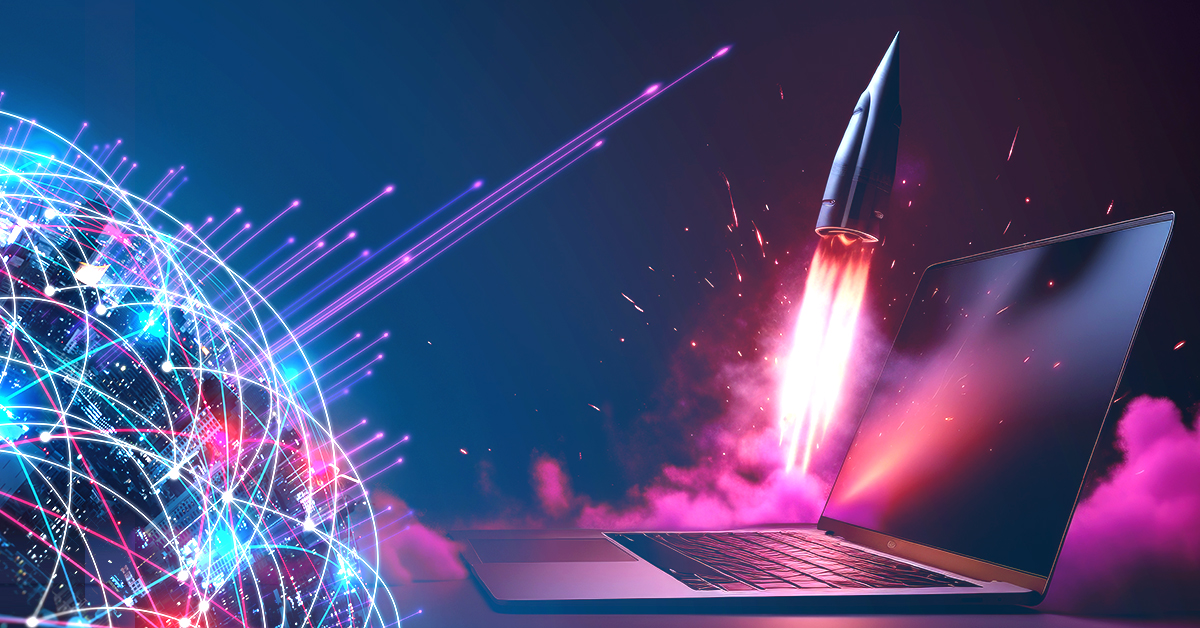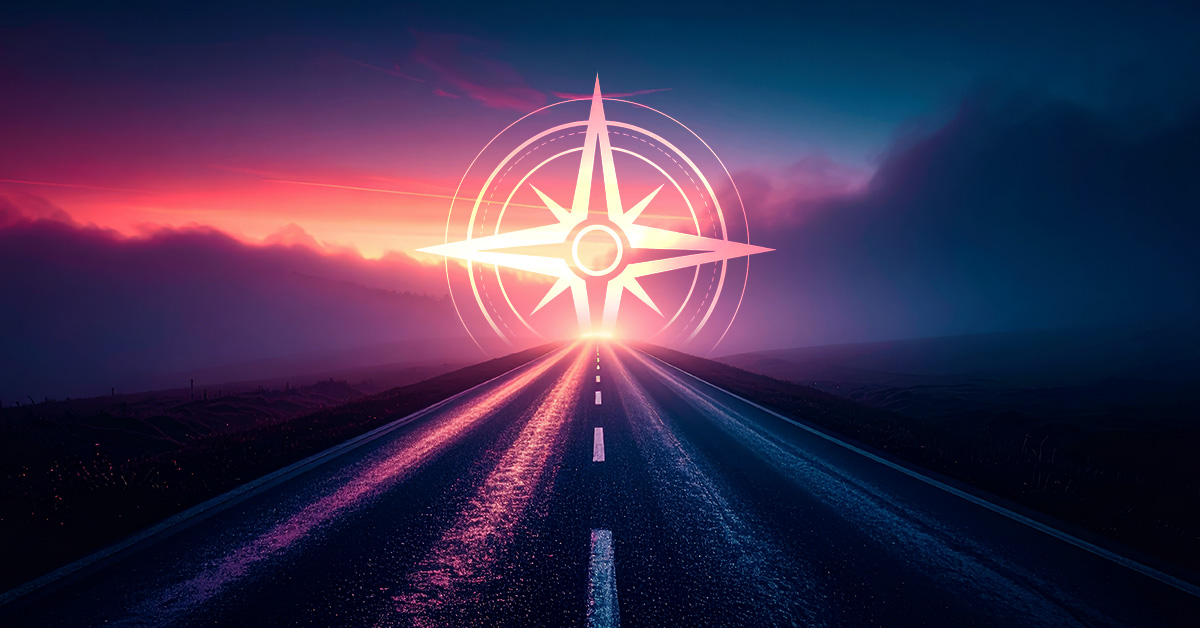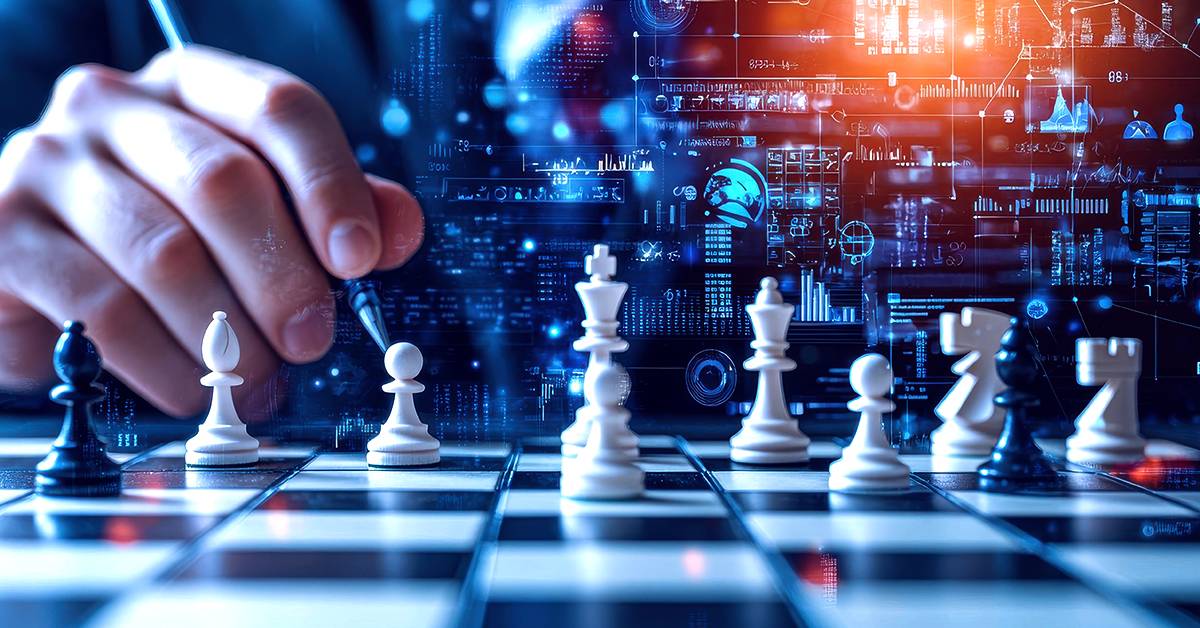- Managed Infrastructure and Cloud Services
- 5G


Emma Mak • Staff Writer
With the rapid pace of technological advancements, once-futuristic ideas are now enticingly within our grasp, providing innovative solutions to revolutionize various business functions. Here, we’ll explore the top emerging technologies in 2024 that are poised to transform the enterprise landscape.
1. Private and Hybrid 5G Networks
“As 5G technology becomes embedded in consumer and enterprise applications, it will drive wider economic growth – it is projected to contribute almost $900 billion to the global economy by 2030.” — GSMA Intelligence
Enhancing Connectivity
Private and hybrid 5G networks are gaining traction as enterprise companies seek more control over their connectivity solutions. Unlike public 5G, private networks provide dedicated bandwidth, enhanced security, and customizable solutions tailored to specific organizational needs. With faster speeds and lower latency, 5G is set to unlock new possibilities in various industries.
Industry-specific strategies:
- Retail: Implement private 5G to enable real-time inventory management and enhance the customer experience with personalized digital signage.
- Finance: Use dedicated networks for secure transactions and data analytics, ensuring compliance with regulatory standards while minimizing latency.
- Healthcare: Leverage private 5G for telemedicine and remote patient monitoring, allowing for quick data exchange and maintaining patient privacy.
Benefits:
- Remote Work: 5G supports high-quality video conferencing and real-time collaboration tools, making remote work more efficient and effective.
- Enhanced Mobile Connectivity: 5G enables seamless connectivity for mobile workforces, ensuring productivity on the go.
- IoT Integration: The high bandwidth and low latency of 5G make it ideal for connecting a vast number of IoT devices, facilitating smarter operations.
2. IoT Security
“For today’s fragmented Internet of Things (IoT) to reach its potential as a fully interconnected ecosystem, the answer may lie in the convergence of cybersecurity and the IoT.” — McKinsey
Securing the Internet of Things
The Internet of Things (IoT) continues to evolve, bringing new innovations that enhance connectivity and automation across industries. IoT devices collect and share data, enabling smarter decision-making and more efficient operations. With the proliferation of IoT devices, security is a paramount concern.
IoT security is a cybersecurity strategy designed to protect IoT devices and the vulnerable networks they connect to from cyber-attacks. This can be challenging because IoT devices lack built-in security, transfer data over the internet unencrypted, and operate undetected by standard cybersecurity systems.
The importance of IoT devices across industries:
- Predictive Maintenance: IoT sensors monitor equipment health in real-time, predicting failures before they occur and reducing downtime.
- Operational Efficiency: Connected devices streamline operations by automating routine tasks and providing real-time insights.
- Customer Experience: IoT enhances customer experience by enabling personalized services and products tailored to individual needs.
Strategies for IoT security:
- End-to-End Encryption: Implementing strong encryption protocols to protect data at rest and in transit.
- Device Authentication: Ensuring that only authorized devices can access the network.
- Regular Updates: Keeping firmware and software up to date to mitigate vulnerabilities.
3. Smart Spaces
“Smart spaces are physical environments in which humans and technology-enabled systems interact in increasingly open, connected, coordinated and intelligent ecosystems.” — Gartner
Future of Work and Living
Smart spaces integrate technology into physical environments. These spaces are designed to improve interaction between humans and technology, making environments more adaptive, efficient, and user-friendly.
Industry-specific strategies:
- Retail: Use smart spaces to enhance customer engagement through interactive displays and tailored shopping experiences.
- Finance: Create smart office environments that enhance collaboration and optimize workspace to improve productivity among teams.
- Healthcare: Design facilities with smart technologies for monitoring patient flow and automating administrative tasks, improving operational efficiency.
Key features:
- Enhanced Collaboration: Smart offices use technology to improve collaboration, from booking meeting rooms to integrating virtual and in-person meetings seamlessly.
- IoT Integration: Sensors and devices communicate to optimize lighting, heating, and security.
- Automation: Smart buildings can automate routine tasks, such as managing energy consumption or scheduling maintenance.
4. Digital Twins
“By using data to mirror real-world situations, digital twins can be deployed to create, fine-tune, or entirely reimagine nearly any complex process or system, including supply chains, public transit systems, and assembly lines.” — McKinsey
Bridging the Physical and Digital Worlds
Digital twins are digital replicas of physical assets, processes, or systems that allow organizations to simulate, predict, and optimize performance in real-time. Mckinsey describes them as “a laboratory in which nearly any organization can optimize its most precious resource — information — to continually push the boundaries of what it can accomplish.” Gartner’s Emerging Tech Impact Radar highlights digital twins as a key technology for enhancing competitive edge and operational efficiency.
Industry-specific strategies:
- Retail: Develop digital twins of store layouts to test and optimize customer flow, enabling data-driven decisions that enhance the shopping experience.
- Finance: Create digital replicas of financial processes to simulate market changes, improving risk assessments and strategic planning.
- Healthcare: Utilize digital twins of patients to tailor treatment plans and monitor health outcomes, leading to more personalized and effective care.
Key features:
- Enhanced Predictive Analytics: By analyzing data trends, digital twins can forecast maintenance needs or operational disruptions, helping to mitigate risks.
- Real-Time Monitoring: Continuous data flows allow for instantaneous updates and insights, supporting proactive management decisions.
- Simulation Models: Organizations can run ‘what-if’ scenarios to understand potential impacts before implementing changes in the real world.
5. AI in Everything
“Generative AI has entered the commercialization phase, making a big impact across industries. It’s transforming business and service models, boosting efficiency in knowledge work, and ushering in a new mode of computing that will blur the lines between digital and physical.” — Info-Tech Research Group
The Game Changer
Generative AI has moved from the research labs into the commercialization phase, transforming business and service models. Unlike traditional AI that relies on pre-programmed responses, generative AI creates new content — from text to images and videos — by learning from existing data. This technology is revolutionizing knowledge work and enhancing efficiency. From customer service to supply chain management, AI is driving efficiency and innovation across the board.
Why it matters:
- Customer Service: AI-powered chatbots and virtual assistants provide 24/7 support, improving customer satisfaction and reducing operational costs.
- Human Resources: AI streamlines recruitment processes by scanning resumes and predicting candidate success, saving valuable time for HR teams.
- Predictive Analytics: AI algorithms analyze historical data to forecast trends, helping businesses make informed decisions.
- Design and Prototyping: AI-driven design tools can generate multiple design prototypes, speeding up development timelines and fostering creativity.
- Revolutionizing IT Operations: AIOps embodies the seamless integration of AI within traditional IT operations, driving efficiency and enabling organizations to harness data for informed decision-making and improved service delivery.
Conclusion
With rapidly evolving breakthroughs in the IT landscape, enterprise companies now have unprecedented opportunities to enhance efficiency, gain insights, and maintain a competitive edge. By staying informed about these emerging technologies, businesses can strategically integrate them into their operations, driving growth and innovation.
Ready to take your enterprise to the next level? Our experts can help you set up your IT operations so you’re ready to harness the power of emerging technologies.
RecenT

The Mac Management Playbook: 8 Steps to Deployment at Scale

Full Lifecycle, Full Visibility: Maximizing the Value of Mac in the Enterprise

Mac in the Enterprise — Myth vs. Reality: Debunking the Top Barriers to Adoption

Maturity Assessments Set a Clear Path to IT Modernization

Opportunity in Uncertainty: Leveraging Data for Fearless Decision-Making

Opportunity in Uncertainty: Turning 6 Top IT Challenges into Strategic Advantages
TOPICS
5 Emerging Technologies for the Enterprise in 2024
- Managed Infrastructure and Cloud Services
- 5G

Emma Mak • Staff Writer
With the rapid pace of technological advancements, once-futuristic ideas are now enticingly within our grasp, providing innovative solutions to revolutionize various business functions. Here, we’ll explore the top emerging technologies in 2024 that are poised to transform the enterprise landscape.
1. Private and Hybrid 5G Networks
“As 5G technology becomes embedded in consumer and enterprise applications, it will drive wider economic growth – it is projected to contribute almost $900 billion to the global economy by 2030.” — GSMA Intelligence
Enhancing Connectivity
Private and hybrid 5G networks are gaining traction as enterprise companies seek more control over their connectivity solutions. Unlike public 5G, private networks provide dedicated bandwidth, enhanced security, and customizable solutions tailored to specific organizational needs. With faster speeds and lower latency, 5G is set to unlock new possibilities in various industries.
Industry-specific strategies:
- Retail: Implement private 5G to enable real-time inventory management and enhance the customer experience with personalized digital signage.
- Finance: Use dedicated networks for secure transactions and data analytics, ensuring compliance with regulatory standards while minimizing latency.
- Healthcare: Leverage private 5G for telemedicine and remote patient monitoring, allowing for quick data exchange and maintaining patient privacy.
Benefits:
- Remote Work: 5G supports high-quality video conferencing and real-time collaboration tools, making remote work more efficient and effective.
- Enhanced Mobile Connectivity: 5G enables seamless connectivity for mobile workforces, ensuring productivity on the go.
- IoT Integration: The high bandwidth and low latency of 5G make it ideal for connecting a vast number of IoT devices, facilitating smarter operations.
2. IoT Security
“For today’s fragmented Internet of Things (IoT) to reach its potential as a fully interconnected ecosystem, the answer may lie in the convergence of cybersecurity and the IoT.” — McKinsey
Securing the Internet of Things
The Internet of Things (IoT) continues to evolve, bringing new innovations that enhance connectivity and automation across industries. IoT devices collect and share data, enabling smarter decision-making and more efficient operations. With the proliferation of IoT devices, security is a paramount concern.
IoT security is a cybersecurity strategy designed to protect IoT devices and the vulnerable networks they connect to from cyber-attacks. This can be challenging because IoT devices lack built-in security, transfer data over the internet unencrypted, and operate undetected by standard cybersecurity systems.
The importance of IoT devices across industries:
- Predictive Maintenance: IoT sensors monitor equipment health in real-time, predicting failures before they occur and reducing downtime.
- Operational Efficiency: Connected devices streamline operations by automating routine tasks and providing real-time insights.
- Customer Experience: IoT enhances customer experience by enabling personalized services and products tailored to individual needs.
Strategies for IoT security:
- End-to-End Encryption: Implementing strong encryption protocols to protect data at rest and in transit.
- Device Authentication: Ensuring that only authorized devices can access the network.
- Regular Updates: Keeping firmware and software up to date to mitigate vulnerabilities.
3. Smart Spaces
“Smart spaces are physical environments in which humans and technology-enabled systems interact in increasingly open, connected, coordinated and intelligent ecosystems.” — Gartner
Future of Work and Living
Smart spaces integrate technology into physical environments. These spaces are designed to improve interaction between humans and technology, making environments more adaptive, efficient, and user-friendly.
Industry-specific strategies:
- Retail: Use smart spaces to enhance customer engagement through interactive displays and tailored shopping experiences.
- Finance: Create smart office environments that enhance collaboration and optimize workspace to improve productivity among teams.
- Healthcare: Design facilities with smart technologies for monitoring patient flow and automating administrative tasks, improving operational efficiency.
Key features:
- Enhanced Collaboration: Smart offices use technology to improve collaboration, from booking meeting rooms to integrating virtual and in-person meetings seamlessly.
- IoT Integration: Sensors and devices communicate to optimize lighting, heating, and security.
- Automation: Smart buildings can automate routine tasks, such as managing energy consumption or scheduling maintenance.
4. Digital Twins
“By using data to mirror real-world situations, digital twins can be deployed to create, fine-tune, or entirely reimagine nearly any complex process or system, including supply chains, public transit systems, and assembly lines.” — McKinsey
Bridging the Physical and Digital Worlds
Digital twins are digital replicas of physical assets, processes, or systems that allow organizations to simulate, predict, and optimize performance in real-time. Mckinsey describes them as “a laboratory in which nearly any organization can optimize its most precious resource — information — to continually push the boundaries of what it can accomplish.” Gartner’s Emerging Tech Impact Radar highlights digital twins as a key technology for enhancing competitive edge and operational efficiency.
Industry-specific strategies:
- Retail: Develop digital twins of store layouts to test and optimize customer flow, enabling data-driven decisions that enhance the shopping experience.
- Finance: Create digital replicas of financial processes to simulate market changes, improving risk assessments and strategic planning.
- Healthcare: Utilize digital twins of patients to tailor treatment plans and monitor health outcomes, leading to more personalized and effective care.
Key features:
- Enhanced Predictive Analytics: By analyzing data trends, digital twins can forecast maintenance needs or operational disruptions, helping to mitigate risks.
- Real-Time Monitoring: Continuous data flows allow for instantaneous updates and insights, supporting proactive management decisions.
- Simulation Models: Organizations can run ‘what-if’ scenarios to understand potential impacts before implementing changes in the real world.
5. AI in Everything
“Generative AI has entered the commercialization phase, making a big impact across industries. It’s transforming business and service models, boosting efficiency in knowledge work, and ushering in a new mode of computing that will blur the lines between digital and physical.” — Info-Tech Research Group
The Game Changer
Generative AI has moved from the research labs into the commercialization phase, transforming business and service models. Unlike traditional AI that relies on pre-programmed responses, generative AI creates new content — from text to images and videos — by learning from existing data. This technology is revolutionizing knowledge work and enhancing efficiency. From customer service to supply chain management, AI is driving efficiency and innovation across the board.
Why it matters:
- Customer Service: AI-powered chatbots and virtual assistants provide 24/7 support, improving customer satisfaction and reducing operational costs.
- Human Resources: AI streamlines recruitment processes by scanning resumes and predicting candidate success, saving valuable time for HR teams.
- Predictive Analytics: AI algorithms analyze historical data to forecast trends, helping businesses make informed decisions.
- Design and Prototyping: AI-driven design tools can generate multiple design prototypes, speeding up development timelines and fostering creativity.
- Revolutionizing IT Operations: AIOps embodies the seamless integration of AI within traditional IT operations, driving efficiency and enabling organizations to harness data for informed decision-making and improved service delivery.
Conclusion
With rapidly evolving breakthroughs in the IT landscape, enterprise companies now have unprecedented opportunities to enhance efficiency, gain insights, and maintain a competitive edge. By staying informed about these emerging technologies, businesses can strategically integrate them into their operations, driving growth and innovation.
Ready to take your enterprise to the next level? Our experts can help you set up your IT operations so you’re ready to harness the power of emerging technologies.
Recent Blogs

The Mac Management Playbook: 8 Steps to Deployment at Scale

Full Lifecycle, Full Visibility: Maximizing the Value of Mac in the Enterprise

Mac in the Enterprise — Myth vs. Reality: Debunking the Top Barriers to Adoption

Maturity Assessments Set a Clear Path to IT Modernization

Opportunity in Uncertainty: Leveraging Data for Fearless Decision-Making




